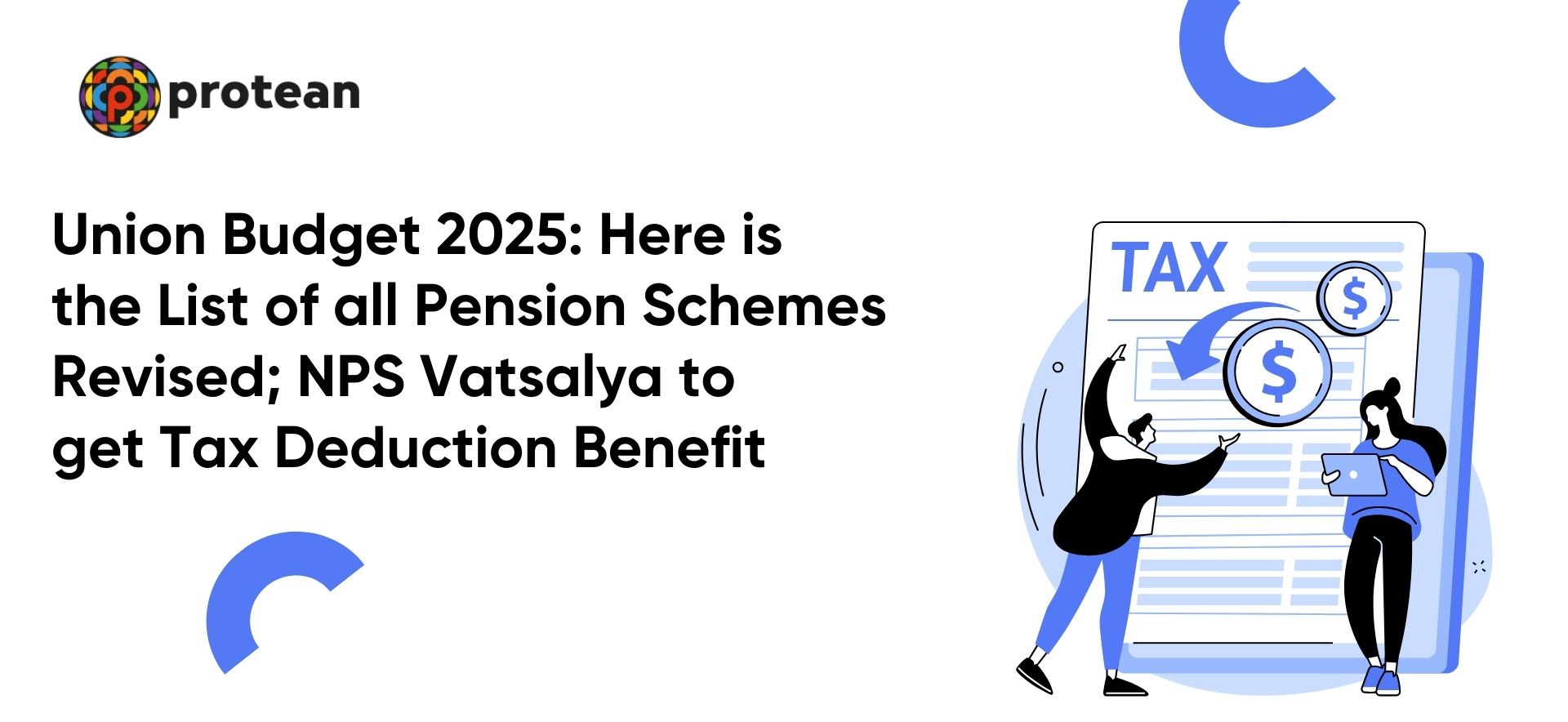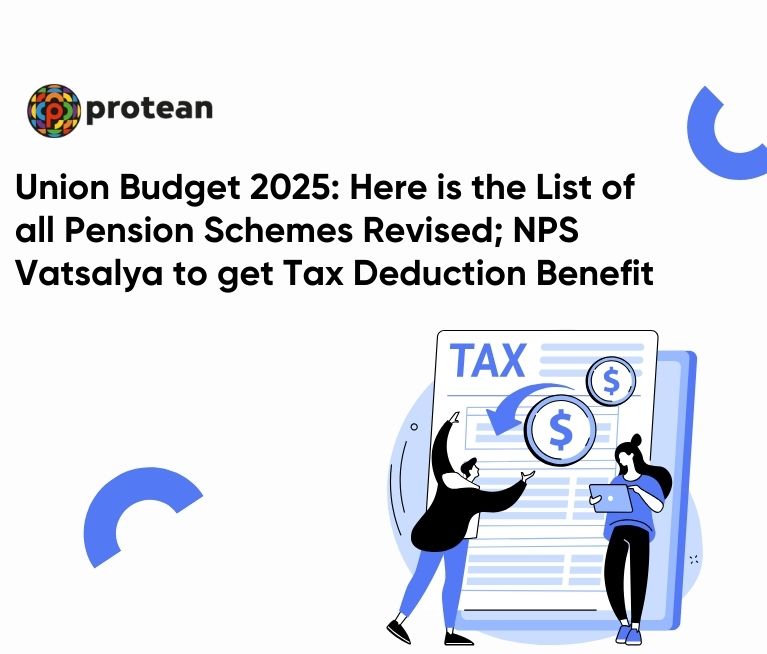The Union Budget 2025 has brought several important changes to pension schemes that are expected to affect many citizens across the country. These changes aim to improve financial security for retirees, encourage people to plan for their retirement, and introduce new tax benefits.
In this article, we will explore the key revisions made to pension schemes, including the introduction of tax benefits for the NPS Vatsalya scheme, updates to welfare pensions for certain senior citizen categories, and other important changes. We will also discuss what these changes typically mean for salaried individuals and pensioners.
Pension Schemes and Tax Benefits: A Quick Overview
| Schemes/Tax Benfits | Key Feature | Old Tax Regime | New Tax Regime (FY 2025-26) | Target Group |
| NPS Vatsalya Scheme | A dedicated investment fund under NPS for securing a child's long-term financial future, including retirement. Parents contribute on behalf of a minor child. | Enhanced Deduction: Additional deduction of up to ₹50,000 under Section 80CCD(1B), over and above the ₹1.5 lakh under Section 80C. | Enhanced Deduction: Additional deduction is not available to those opting for the New Tax Regime. | Parents/Guardians investing for their minor children's future. |
| National Pension System (NPS) | Market-linked, defined contribution retirement saving scheme for all citizens. (General provisions, no universal overhaul in Budget 2025). | Employee Contribution: Eligible for deduction under section 80CCD(1) (up to ₹1.5 lakh combined with 80C limit) and an additional deduction under 80CCD(1B) (up to ₹50,000 over and above 80C). | Employee Contribution: Generally, no deduction (except 80CCD(1B) for self-contribution, if opted out of the default simplified new regime and specific conditions met). Employer Contribution: Remains deductible for the employee under 80CCD(2) (up to 14% for Central Govt. employees). | Government, private, and self-employed individuals. |
| Unified Pension Scheme (UPS) | An optional pension scheme for Central Government employees under NPS, offering a guaranteed minimum pension of ₹10,000 per month after 10 or more years of service. It operates as a fund-based system under the NPS architecture. | Not directly applicable as this is a specific option for Central Govt. employees already under NPS. | (For Central Govt. Employees under NPS only) Guaranteed Minimum Pension: ₹10,000/month for 10+ year’s service. | Central Government Employees (existing under NPS as of 01.04.2025, or new recruits). |
| Standard Deduction | A flat deduction from gross salary/pension income for salaried individuals and pensioners. | Unchanged: Remains at ₹50,000. (For family pensioners, it's ₹15,000 or 33.33% of pension, whichever is less). | Unchanged from previous Budget's revision: Remains at ₹75,000 for salaried employees and pensioners. (For family pensioners, it's ₹25,000 or 33.33% of pension, whichever is less). | Salaried individuals, pensioners, and family pensioners. |
Key Changes in Pension Schemes
The Union Budget 2025 brought major updates to pension plans, largely focusing on providing better financial security for retirees and promoting structured retirement planning. The government made changes in three key areas: tax advantages, standard deductions, and new pension structures.
Enhanced Tax Relief for NPS Vatsalya Scheme
- What it is: The NPS Vatsalya Scheme is a proposed initiative within the National Pension System aimed at enabling parents to contribute towards their minor children's long-term financial future, pending official notification from PFRDA.
- The change: Additional Deduction of up to ₹50,000 under Section 80CCD(1B) is not available to those opting for the New Tax Regime.
Revised Standard Deduction for Pensioners (and Salaried Individuals)
- What it is: A fixed deduction from taxable salary or pension income.
- The change: While the standard deduction under the Old Tax Regime remained at ₹50,000, for those opting for the New Tax Regime, it was confirmed and clarified as ₹75,000 for salaried employees and pensioners. This change was a carryover from a previous budget but its application in FY 2025-26 solidifies a larger tax-free income slab, especially for those with moderate incomes choosing the simplified regime. For family pensioners, the standard deduction under the new tax regime was increased to ₹25,000 from ₹15,000.
| Also Read: NPS Tax Benefits for Investors |
What These Changes Mean for Taxpayers
The updates to pension plan in the 2025 Union Budget generally aim to improve retirement planning and give retirees more financial security. However, the impact on individuals depends on their financial situation.
Encouraging Child Welfare Investments through NPS Vatsalya
The Budget 2025 introduced a powerful incentive for parents looking to secure their children's financial future.
- Additional Tax Deduction for NPS Vatsalya: Contributions to the NPS Vatsalya Scheme, which focuses on child welfare, will now be eligible for an additional deduction of up to ₹50,000 under Section 80CCD(1B). This is over and above the existing ₹1.5 lakh limit under Section 80C.
- What this means for you: This offers a unique dual tax benefit for parents. You can effectively save more for your child's long-term financial security (including their retirement corpus) while simultaneously reducing your current taxable income, making it a highly tax-efficient savings avenue.
| Also Read: NPS Vatsalya Account Opening |
Relief for the Middle Class and Salaried Individuals
A significant thrust of the Budget 2025 was to enhance disposable income for low and middle-income groups, particularly those embracing the New Tax Regime.
- Higher Tax-Free Income under New Tax Regime: For salaried individuals, the effective tax-free income limit has now extended to ₹12.75 lakh per annum under the New Tax Regime. This is a combination of a higher rebate limit (income up to ₹12 lakh now effectively tax-free) and the enhanced standard deduction.
- Increased Standard Deduction (New Tax Regime): The standard deduction for salaried individuals and pensioners under the New Tax Regime has been reaffirmed at ₹75,000. This is a direct benefit, allowing a larger portion of income to be tax-exempt without needing to opt for specific investments. While the Old Tax Regime's standard deduction remains ₹50,000, the increased limit in the new regime makes it a more compelling choice for many who prefer simplicity over claiming numerous deductions.
- For Family Pensioners: Those receiving family pensions under the New Tax Regime will also benefit from an increased standard deduction of ₹25,000 (up from ₹15,000).
- What this means for you: If you are a salaried individual or a pensioner, especially if you haven't traditionally maximized deductions under the Old Tax Regime, the New Tax Regime has become even more attractive. You could potentially see a lower tax outflow and a simpler tax filing process.
Significant Boost for Senior Citizens
Senior citizens are among the biggest beneficiaries of the Budget 2025, with several measures aimed at improving their financial security and ease of life.
- Doubled Deduction for Interest Income: The deduction limit on interest income for senior citizens under Section 80TTB has been increased from ₹50,000 to a substantial ₹1 lakh. This is a major relief, allowing them to earn more interest from their deposits and savings without it being subject to income tax.
- Higher TDS Threshold on Rent Payments: The annual TDS threshold for rent payments has been raised significantly from ₹2.40 lakh to ₹6 lakh. This reduces the compliance burden for many senior citizens who rely on rental income from their properties, as fewer will now need to deal with TDS implications.
- Tax Exemption for NSS Withdrawals: Withdrawals from National Savings Scheme (NSS) accounts are now fully tax-exempt (effective August 29, 2024). This provides greater liquidity and a tax-efficient avenue for seniors who have invested in these government-backed small savings schemes.
- What this means for you: If you are a senior citizen, these changes directly translate into higher net income from your investments and rental properties, along with simplified tax compliance, contributing to greater financial comfort in your retirement years.
| Also Read: NPS Vatsalya Benefits Guide |
Conclusion
The Union Budget 2025 focused on enhancing financial security for retirees and strengthening retirement planning provisions. Enhancing NPS participation benefits and revising deductions for senior citizens reflect positive intent. However, despite the increase in standard deduction, many salaried individuals and pensioners still hoped for higher relief and rising costs. Overall, the budget aims to balance fiscal duty with providing different sections of society with financial security. Taxpayers should carefully review the changes to grasp their impact on retirement strategies.
By staying informed, individuals can take advantage of new opportunities and ensure long-term financial well-being. Though mixed, these revisions compel taxpayers to make thoughtful financial choices.
Frequently Asked Questions
1. Which pension scheme got additional tax benefits in the Budget 2025?
The additional ₹50,000 deduction under Section 80CCD(1B) for NPS contributions continues unchanged; no new child welfare scheme was added. This is over and above the ₹1.5 lakh deduction limit under Section 80C.
2. Has the standard deduction limit been increased in the recent budget?
Yes, the standard deduction limit has been increased from ₹50,000 to ₹75,000 for the New Tax Regime under Union Budget 2025.
3. Who will benefit from the additional ₹50,000 deduction under NPS Vatsalya?
The ₹50,000 additional deduction under Section 80CCD(1B) continues to benefit NPS subscribers contributing to Tier-I accounts, encouraging long-term retirement savings.

